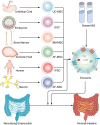Current therapy option for necrotizing enterocolitis: Practicalities and challenge
- PMID: 35967586
- PMCID: PMC9366471
- DOI: 10.3389/fped.2022.954735
Current therapy option for necrotizing enterocolitis: Practicalities and challenge
Abstract
Necrotizing enterocolitis (NEC) is one of the most prevalent neonatal gastrointestinal disorders. Despite ongoing breakthroughs in its treatment and prevention, the incidence and mortality associated with NEC remain high. New therapeutic approaches, such as breast milk composition administration, stem cell therapy, immunotherapy, and fecal microbiota transplantation (FMT) have recently evolved the prevention and the treatment of NEC. This study investigated the most recent advances in NEC therapeutic approaches and discussed their applicability to bring new insight to NEC treatment.
Keywords: breast milk composition; fecal microbiota transplantation; immunotherapy; necrotizing enterocolitis; stem cell.
Copyright © 2022 Wu, Guo, Zhuo, Zeng, Luo, Yang, Li, Jiang, Huang, Sha and Chen.
Conflict of interest statement
The authors declare that the research was conducted in the absence of any commercial or financial relationships that could be construed as a potential conflict of interest.
Figures



Similar articles
-
Necrotizing enterocolitis: recent advances in treatment with translational potential.Pediatr Surg Int. 2023 May 29;39(1):205. doi: 10.1007/s00383-023-05476-0. Pediatr Surg Int. 2023. PMID: 37247104 Review.
-
Fecal microbiota transplantation by enema reduces intestinal injury in experimental necrotizing enterocolitis.J Pediatr Surg. 2020 Jun;55(6):1094-1098. doi: 10.1016/j.jpedsurg.2020.02.035. Epub 2020 Feb 26. J Pediatr Surg. 2020. PMID: 32234317
-
Colonization of fecal microbiota from patients with neonatal necrotizing enterocolitis exacerbates intestinal injury in germfree mice subjected to necrotizing enterocolitis-induction protocol via alterations in butyrate and regulatory T cells.J Transl Med. 2021 Dec 18;19(1):510. doi: 10.1186/s12967-021-03109-5. J Transl Med. 2021. PMID: 34922582 Free PMC article.
-
Enteral broad-spectrum antibiotics antagonize the effect of fecal microbiota transplantation in preterm pigs.Gut Microbes. 2021 Jan-Dec;13(1):1-16. doi: 10.1080/19490976.2020.1849997. Gut Microbes. 2021. PMID: 33382952 Free PMC article.
-
Stem cells and exosomes: promising candidates for necrotizing enterocolitis therapy.Stem Cell Res Ther. 2021 Jun 5;12(1):323. doi: 10.1186/s13287-021-02389-4. Stem Cell Res Ther. 2021. PMID: 34090496 Free PMC article. Review.
Cited by
-
Plant-Derived Substances for Prevention of Necrotising Enterocolitis: A Systematic Review of Animal Studies.Nutrients. 2024 Mar 14;16(6):832. doi: 10.3390/nu16060832. Nutrients. 2024. PMID: 38542743 Free PMC article.
-
Bone marrow-derived mesenchymal stromal cells in necrotizing enterocolitis treatment: a narrative review.Front Pediatr. 2025 Jul 31;13:1624236. doi: 10.3389/fped.2025.1624236. eCollection 2025. Front Pediatr. 2025. PMID: 40822681 Free PMC article. Review.
-
[Effect of gut microbiota homeostasis on hematopoiesis in a neonatal rat model of necrotizing enterocolitis].Zhongguo Dang Dai Er Ke Za Zhi. 2023 Aug 15;25(8):855-863. doi: 10.7499/j.issn.1008-8830.2301082. Zhongguo Dang Dai Er Ke Za Zhi. 2023. PMID: 37668035 Free PMC article. Chinese.
-
Does protocol miconazole administration improve mortality and morbidity on surgical necrotizing enterocolitis?Pediatr Surg Int. 2023 Feb 4;39(1):102. doi: 10.1007/s00383-023-05390-5. Pediatr Surg Int. 2023. PMID: 36738350
-
Multi-strain Probiotics for Treatment of Necrotizing Enterocolitis in Preterm Rats: Histological and Immunohistochemical Evaluation.Probiotics Antimicrob Proteins. 2025 Jun 5. doi: 10.1007/s12602-025-10611-5. Online ahead of print. Probiotics Antimicrob Proteins. 2025. PMID: 40471534
References
-
- Thyoka M, de Coppi P, Eaton S, Khoo K, Hall NJ, Curry J, et al. Advanced necrotizing enterocolitis part 1: mortality. Eur J Pediatr Surg. (2012) 22:8–12. - PubMed
-
- Spencer AU, Kovacevich D, McKinney-Barnett M, Hair D, Canham J, Maksym C, et al. Pediatric short-bowel syndrome: the cost of comprehensive care. Am J Clin Nutr. (2008) 88:1552–9. - PubMed
-
- Bazacliu C, Neu J. Necrotizing enterocolitis: long term complications. Curr Pediatr Rev. (2019) 15:115–24. - PubMed
-
- Weintraub AS, Ferrara L, Deluca L, Moshier E, Green RS, Oakman E, et al. Antenatal antibiotic exposure in preterm infants with necrotizing enterocolitis. J Perinatol. (2012) 32:705–9. - PubMed
Publication types
LinkOut - more resources
Full Text Sources

